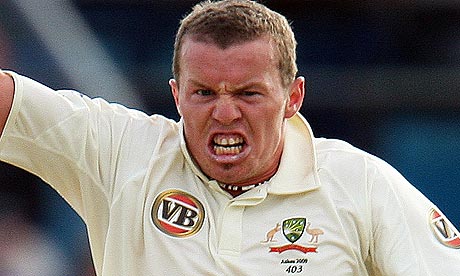For those of you who have been living under a rock (or are American), the Ashes begins today. Or is it tomorrow? One never really knows with events that are occurring in Australia. If you’re on the east coast of the United States (as I suspect most of you are), it begins at 7:00 PM on Wednesday. If you’re in England (I know there are a few of you), it’ll be midnight Wednesday/Thursday. And if you’re in Australia, well then you don’t really need an American to tell you anything about the Ashes, do you?
Right, so what’s the Ashes? Only the biggest cricket series in the world. If you’ve been over to our apartment in the U.S., you’ve no doubt noticed the 3-DVD 2005 Ashes box set. It’s kind of a big deal. But never fear, reader, I’ll get you up to speed just in time.
What you need to know
- Still unsure about what cricket’s all about? Can’t tell an LBW from a silly point? Becca’s wonderful tutorial is the place to start. The one wrinkle for the Ashes is that all these matches are of the multi-day variety, which means each team bats twice rather than just once. And by “multi-day,” I mean up to 5 days.
- Every other year, England and Australia play each other in a 5-match series to determine world cricket supremacy. Or so they like to think – as of right now, they’re ranked 4th and 5th in the world, so it’s more like supremacy within the mediocre ranks of Test-playing nations. Still, if you gave most England cricket fans a choice between winning the Ashes (especially in Australia) and winning the World Cup, I’d suspect they’d choose the former.
 The winner of the series gets a (replica of) trophy. And by trophy I mean a tiny urn. It’s got to be the most ridiculous trophy in sports.
The winner of the series gets a (replica of) trophy. And by trophy I mean a tiny urn. It’s got to be the most ridiculous trophy in sports. - The 2005 Ashes in England (which England won 2-1 in thrilling style) is widely held to be the greatest series of cricket in history. It’s no coincidence that I started following cricket at exactly this time.
- In 2006-7, England sought to retain the Ashes when they traveled to Australia. They failed to do so, losing 5-0 in what turned out to be the farewell series for Australian bowlers Glenn McGrath and Shane Warne, two of the all-time greats. In retrospect, the first ball of the series, bowled by England fast bowler Stephen Harmison, gave a pretty clear sense of how the whole trip would go for England.
- Last summer England took the Ashes back, once again winning the series 2-1 in England (and Wales). England’s victories never seem to be as resounding as their defeats.
- So that brings us to today (or tomorrow). England are back in Australia, convinced that this is the year when they’ll finally beat Australia in Australia. There are some good reasons for thinking this:
- Australia, once all-conquering marauders with cut-throat instincts, have suddenly forgotten how to close out matches. Test matches are won as a result of five days of intensity and concentration. If Australia continue to slip up…
- England have been playing wonderfully. They’ve been the better team by some distance in all their warm-up matches in Australia, including the one where they didn’t play any of their best bowlers.
- Graeme Swann. Clearly a man who does 1,000 push-ups is unstoppable. [Watch all the way through. Really.]
- The cast of characters. Here are some of the key players on each side.
- England
 Andrew Strauss – England’s South Africa-born captain and opening batsman. You can spot him by the wedding ring he wears on a necklace. In true captain form, you can expect plenty of bland cliches about taking each session/day/match one session/day/match at a time.
Andrew Strauss – England’s South Africa-born captain and opening batsman. You can spot him by the wedding ring he wears on a necklace. In true captain form, you can expect plenty of bland cliches about taking each session/day/match one session/day/match at a time. - Jonathan Trott – England’s South Africa-born #3 batsman. Known for the digging trenches while batting. You can also see him in the video above at 8:35
 Kevin Pietersen – England’s South Africa-born #4 batsman. Typically described with words like ‘brilliant,’ ‘mercurial,’ and ‘aggravating.’ Currently sporting a mustache for Movember, though he has some aspects of the pantomime villain, so I wouldn’t be surprised if he kept it. Fun facts: middle name is Peter. Born in Pietermaritzburg. You can’t make this stuff up.
Kevin Pietersen – England’s South Africa-born #4 batsman. Typically described with words like ‘brilliant,’ ‘mercurial,’ and ‘aggravating.’ Currently sporting a mustache for Movember, though he has some aspects of the pantomime villain, so I wouldn’t be surprised if he kept it. Fun facts: middle name is Peter. Born in Pietermaritzburg. You can’t make this stuff up.  Paul Collingwood – England’s Northern ginger batsman. Typically described as a ‘nurdler’ and ‘nuggety’. Which means, more or less, that he’s not very talented. He’s what American baseball fans would call ‘scrappy’. Look for him to hang around, as they say. Also one of the world’s top fielders, although the frequency of his drops is on the increase.
Paul Collingwood – England’s Northern ginger batsman. Typically described as a ‘nurdler’ and ‘nuggety’. Which means, more or less, that he’s not very talented. He’s what American baseball fans would call ‘scrappy’. Look for him to hang around, as they say. Also one of the world’s top fielders, although the frequency of his drops is on the increase.  Ian Bell – England’s Midlands ginger batsman. He seems to have recovered from his broken foot. Known for making very pretty 30s and 40s but then needlessly getting himself out.
Ian Bell – England’s Midlands ginger batsman. He seems to have recovered from his broken foot. Known for making very pretty 30s and 40s but then needlessly getting himself out. - Matt Prior – England’s South Africa-born wicketkeeper/batsman. Not too much to say about him – steady with the bat and gloves. I mostly just wanted to highlight the fact that England have four players born in South Africa. South Africa, incidentally, also plays Test cricket.
 Stuart Broad – One of England’s pretty young fast bowlers. Turns out he can bat a bit, too, though his dancing leaves something to be desired.
Stuart Broad – One of England’s pretty young fast bowlers. Turns out he can bat a bit, too, though his dancing leaves something to be desired. - Graeme Swann – The video above says it all, really.
- Australia
 Shane Watson – It is not possible to imagine someone looking more Australian. As my friend Ivan points out, all he needs is a surfboard under his arm. In spite of his hulking physique, known for frequent injuries and crying.
Shane Watson – It is not possible to imagine someone looking more Australian. As my friend Ivan points out, all he needs is a surfboard under his arm. In spite of his hulking physique, known for frequent injuries and crying. - Ricky Ponting – Arguably the second-best Australian batsman ever. Has something of a temper, as this clip shows. If things go poorly, his captaincy could be under threat.
- Michael Clarke – Another injury-prone batsman who can bowl a bit. His latest injury is a sore back, and his readiness for the first Test match remains in doubt. Long seen as Ponting’s successor as captain, Clarke’s been the subject of some discontent in the locker room recently.
- Mitchell Johnson, Ben Hilfenhaus, Peter Siddle, and Doug Bollinger – Australian fast bowlers of various sorts. All seem to have a distinguishing physical characteristic, so you should be able to distinguish them pretty easily: Johnson has a narrow, aerodynamic face; Hilfenhaus always sports some manly stubble; Siddle just looks mean; Bollinger just looks goofy. Only three of this group are likely to play in any one match.
- England




- Staying up late watching cricket is hard work – it’s not as if there’s constant action to keep you biting your nails the whole night through. Fortunately, the Guardian comes through with a guide to how to stay awake. Apparently bacon and eggs are key components.
How to follow the action
- The classic English way of following the Ashes is listening to Test Match Special and its inimitable cast of characters. You may or may not be able to listen from the US, but if you are, this is the way to go.
- Follow the ball-by-ball descriptions at cricinfo. The Guardian’s over-by-over coverage offers a slightly more sedate pace with more jokes. This tends to work better if you’ve got a handle on the lingo, but you can learn fast if you keep this open at all times.
- For the twitterers out there, @Aggerscricket and @Swannyg66are the ones to follow.
- If you’re really committed, you can even spring for a package from Willow TV and watch the action to your heart’s content. It’s not cheap, but if you find yourself with a spare 150 hours over the next six weeks, why not?
- Keep reading here, of course. Chances are I’ll be jotting down at least a few thoughts on each day’s play, especially since Becca’s not here to listen to my daily gushings. My apologies, in advance, if the terminology rapidly becomes obscure and silly. Feel free to ask for clarification.
What to look for
- Cricket scores are notoriously opaque to non-cricket fans. It’s too complicated (how many wickets are down, what’s the pitch doing, etc.) to provide any easy guide, but it’s safe to say that a team scoring 100 runs in its whole innings has done very poorly and is likely on its way to a quick defeat. Likewise, a team that puts up 500 runs in its innings is a pretty safe bet to win or at least put the other team under severe pressure. There have been exceptions. In general, big numbers before the slash and small numbers (say, 0-4) after it are good for the batting team.
- How many players will Australia use throughout the series? Even on the eve of the first match, they’re basically undecided about who’s going to be playing for them. If things go poorly in the first match, look for the Australian selectors to make significant changes in the lineup in an attempt to save face. By that point, it may already be too late.
- If you’re listening to Test Match Special, play some Boycott bingo. If you’ve ever wondered what a crusty old Yorkshireman sounds like, this is your chance.
- How many posts on cricket can I possibly write in a six-week period?



I'm glad you have a good distraction to Becca being away!
ReplyDeleteMom